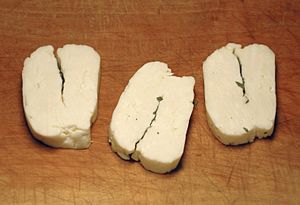Halloumi facts for kids
Halloumi is a special kind of cheese that comes from the island of Cyprus. It's usually made from goat's milk or sheep's milk, and sometimes even cow's milk. What makes Halloumi unique is that you can fry or grill it without it melting! Instead, it gets a lovely golden-brown crust and a soft inside. It's a bit salty and has a fun, squeaky texture when you chew it.
Contents
Where Halloumi Comes From
Halloumi from Cyprus
Halloumi cheese first appeared in Cyprus a very long time ago, during the Middle Ages. This was when the Byzantine Empire was still powerful, between the years 395 and 1191 AD. From Cyprus, this tasty cheese spread across the Middle East.
Cypriot farmers relied on Halloumi for food because it was full of protein. In many villages, everyone would work together to make large amounts of cheese. Each village had its own special way of making it, with unique techniques and secret ingredients. Halloumi became so important that some Cypriot family names, like Hallumas, Halluma, and Hallumakis, even came from its production.
Halloumi is white and has layers, a bit like mozzarella. It has a salty taste and is stored in its own natural juices. People often add mint leaves to it. This tradition started because mint helps the cheese stay fresh and taste better for longer. That's why you'll often find small pieces of mint leaves on the cheese in its packaging.
Cooking with Halloumi
This cheese is great for cooking because it doesn't melt easily, even when heated. This special quality makes it perfect for frying or grilling. You can fry it until it's golden brown and serve it with vegetables, or add it to salads.
Cypriots love to eat Halloumi with watermelon during the warm summer months. Another popular dish is halloumi and lountza. This is a combination of Halloumi cheese with a slice of smoked pork or a soft lamb sausage.
Halloumi doesn't melt because the fresh cheese curd is heated before it's shaped and put into salty water, called brine. Traditional Halloumi is usually shaped like a half-circle, similar to a large wallet. It weighs about 220–270 grams. When you eat it, its firm texture makes it "squeak" a little against your teeth.
Traditionally, Halloumi is made from unpasteurized sheep's milk and goat's milk. Some people also enjoy aged Halloumi. When kept in its brine for a long time, it becomes much drier, stronger, and saltier. This makes it taste very different from the milder Halloumi often found in other countries.
Halloumi is officially recognized as a special Cypriot product in the United States. However, it's still being discussed whether it can be officially protected in the European Union. This is because dairy farmers and sheep/goat farmers disagree on how much cow's milk can be used in "official" Halloumi. Most Cypriots believe that traditional Halloumi was made only from sheep and goat milk, as there were not many cows on the island until the 20th century. But as more people wanted Halloumi, cheese makers started using cheaper and more common cow's milk.
Halloumi in the Middle East
Halloumi is also a common food in many parts of the Levant region. This includes countries like Lebanon, Turkey, Syria, Palestine, Jordan, Israel, Egypt, and Iraq. It's a traditional part of breakfast in the Levant, eaten fresh or fried, often with other dishes like hummus, falafel, and khubz (bread).
Halloumi cheese is very similar to Nablusi cheese, which is named after the city of Nablus in Palestine. Some people think that Halloumi cheese might have first been made in the Levant because of its similarity to Nablusi cheese and the long history of eating Halloumi in that region. In Israel, Halloumi is sometimes fried in olive oil and served for breakfast or with meze (small dishes). It is also eaten with fish.
Images for kids
See also
 In Spanish: Halloumi para niños
In Spanish: Halloumi para niños




